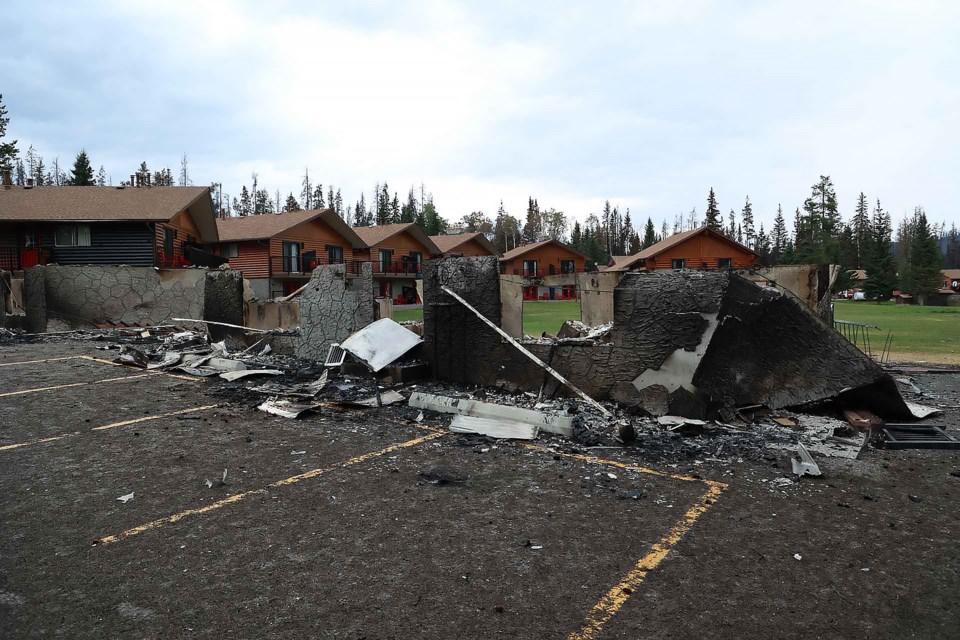BANFF – The Town of Banff wants to develop a comprehensive recovery plan outlining steps for rebuilding and restoring essential operations in the event of future emergency like a devastating wildfire.
With wildfire considered the top threat facing Banff, the recently released draft Banff Community Plan calls for a comprehensive strategy, as well as a structured approach for business continuity, maintaining essential operations and minimizing disruptions during and after an emergency or unexpected event.
“I think that the events in Jasper were very sobering and they’re very eye-opening and we’ve seen our sister community go through the challenges of reopening,” said Banff Mayor Corrie DiManno.
“We are very well-versed in our evacuation planning, but I’d say the conversation of re-entry and recovery with the community is still very new as a concept for folks.”
On July 24, 2024, a devastating wildfire ravaged one-third of the Jasper townsite, destroying 358 of its 1,113 structures, and burning approximately 32,500 hectares of the national park.
Close to 25,000 people, including residents and tourists, were forced to flee the community two days earlier. One firefighter was killed trying to contain the blaze.
The community of Jasper has been struggling to recover, though tourists have been invited to return.
Jasper town council was recently told there will likely be at least a 20 per cent decline in tourism revenues this summer as the park continues to rebuild.
No homes that burned to the ground have been rebuilt so far, although interim housing units were trucked into the town in February.
DiManno said the Jasper wildfire was heartbreaking, and Banff is seeking to be prepared in the event a similar disaster strikes the Bow Valley.
“I like to think about it in the same way as the pandemic. In some ways, it was very easy to essentially shut things down or modify the way that we operated, but to then turn it all back on, it took a lot of time and was more complicated,” she said.
“I liken that to after an emergency and re-entering the community and recovering from the hazardous event, and for us, I think we want to start to really engage the community on this conversation so that you know what everyone's expectations are.”
With wildfire rated the top hazard in Banff, the municipality has shifted its thinking from “if” a wildfire happens to “when”.
DiManno said a comprehensive recovery plan for wildfire, in particular, is a big piece of Banff’s entire emergency management portfolio.
“We know that’s our biggest risk and so we are doing our utmost to be prepared for having to evacuate and protect the town,” she said.
“But it’s also imperative that we are just as prepared for when we need to re-enter the town and restore essential services and get a sense of what recovery could look like for us.”
The long-awaited Banff Community Plan is currently out for public review, with an online survey currently open and a public open house scheduled for April 23.
It is the first time a community plan has spoken in such depth about public safety and wildfire protection.
The draft community plan calls for ongoing promotion of wildfire risk reduction initiatives and programs that meet wildfire prevention best practices and to maintain and regularly update hazard, risk, and vulnerability assessments.
Regular review and update of Town policies and guidelines to incorporate FireSmart building and vegetation management best practices, and ensuring that all municipal properties adhere to these standards, are also a key part of the community plan.
The 51-page document also recommends working on getting long-term funding secured for wildfire protection projects, prioritizing sustained investment for equipment, education, and community initiatives.
Continuing aggressive fuel reduction projects in all fire-prone areas, including ongoing maintenance of previously treated wildfire risk reduction areas, forms part of the draft community plan.
Randall McKay, the Town of Banff’s lead on the rewrite of the community plan and manager of strategic priorities and special projects, said there is new and emerging thinking about community wildfire protection.
“Obviously, the events of the last few years and even recently in the last few months in the United States have certainly driven this,” he said.
“We had a great deal of community interest in community wildfire protection and promoting community wildfire risk reduction and initiatives and this became a very big piece of the plan.”
McKay said developing a recovery plan that outlines steps for rebuilding and restoring essential services after an emergency was strongly recommended by the municipality’s director of emergency and protective services, Katherine Severson.
“It is an area that Katherine Severson has significant experience with,” he said.
“Advisory committee members also strongly endorsed this recommendation based on recent disaster events in Alberta and Northwest Territories.”




